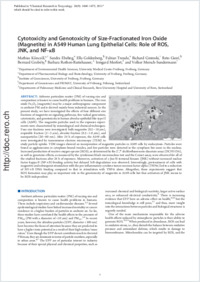Cytotoxicity and genotoxicity of size-fractionated iron oxide (magnetite) in a549 human lung epithelial cells: role of ROS, JNK, and NF-κB
- Könczöl, Mathias Department of Environmental Health Sciences, University Medical Center Freiburg, Germany
- Ebeling, Sandra Department of Pharmaceutical Biology and Biotechnology, University of Freiburg, Germany
- Goldenberg, Ella Institute of Geosciences, University of Freiburg, Germany
- Treude, Fabian Department of Pharmaceutical Biology and Biotechnology, University of Freiburg, Germany
- Gminski, Richard Department of Environmental Health Sciences, University Medical Center Freiburg, Germany
- Gieré, Reto Institute of Geosciences, University of Freiburg, Germany
- Grobéty, Bernard Department of Geosciences and FRIMAT, University of Fribourg, Switzerland
- Rothen-Rutishauser, Barbara Departments of Pulmonary Medicine and Clinical Research, University Hospital and University of Bern, Switzerland
- Merfort, Irmgard Department of Pharmaceutical Biology and Biotechnology, University of Freiburg, Germany
- Mersch-Sundermann, Volker Department of Environmental Health Sciences, University Medical Center Freiburg, Germany
-
27.06.2011
Published in:
- Chemical Research in Toxycology. - 2011, vol. 24, no. 9, p. 1460–1475
English
Airborne particulate matter (PM) of varying size and composition is known to cause health problems in humans. The iron oxide Fe₃O₄ (magnetite) may be a major anthropogenic component in ambient PM and is derived mainly from industrial sources. In the present study, we have investigated the effects of four different size fractions of magnetite on signaling pathways, free radical generation, cytotoxicity, and genotoxicity in human alveolar epithelial-like type-II cells (A549). The magnetite particles used in the exposure experiments were characterized by mineralogical and chemical techniques. Four size fractions were investigated: bulk magnetite (0.2–10 μm), respirable fraction (2–3 μm), alveolar fraction (0.5–1.0 μm), and nanoparticles (20–60 nm). After 24 h of exposure, the A549 cells were investigated by transmission electron microscopy (TEM) to study particle uptake. TEM images showed an incorporation of magnetite particles in A549 cells by endocytosis. Particles were found as agglomerates in cytoplasm-bound vesicles, and few particles were detected in the cytoplasm but none in the nucleus. Increased production of reactive oxygen species (ROS), as determined by the 2′,7′-dichlorfluorescein-diacetate assay (DCFH-DA), as well as genotoxic effects, as measured by the cytokinesis block-micronucleus test and the Comet assay, were observed for all of the studied fractions after 24 h of exposure. Moreover, activation of c-Jun N-terminal kinases (JNK) without increased nuclear factor kappa-B (NF-κB)-binding activity but delayed IκB-degradation was observed. Interestingly, pretreatment of cells with magnetite and subsequent stimulation with the pro-inflammatory cytokine tumor necrosis factor-alpha (TNFα) led to a reduction of NF-κB DNA binding compared to that in stimulation with TNFα alone. Altogether, these experiments suggest that ROS formation may play an important role in the genotoxicity of magnetite in A549 cells but that activation of JNK seems to be ROS- independent.
- Faculty
- Faculté des sciences et de médecine
- Department
- Département de Géosciences
- Language
-
- English
- Classification
- Biology, life sciences
- License
-
License undefined
- Identifiers
-
- RERO DOC 27992
- DOI 10.1021/tx200051s
- Persistent URL
- https://folia.unifr.ch/unifr/documents/302082
Statistics
Document views: 309
File downloads:
- pdf: 380
